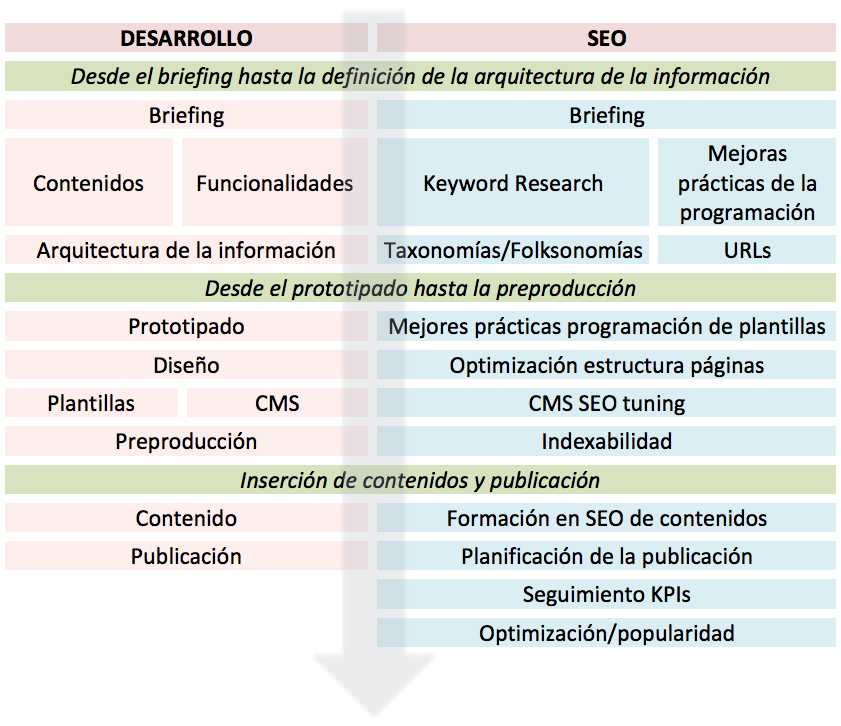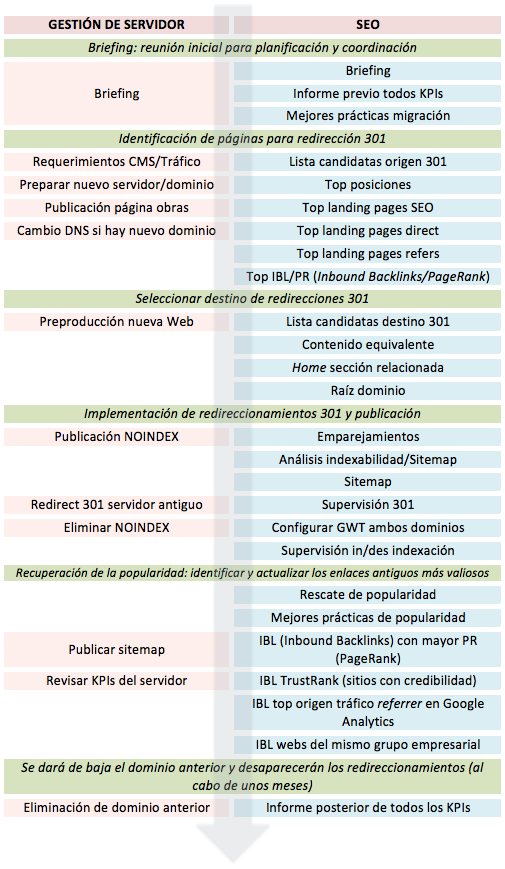Written by Miguel Ángel Culiáñez
As is the case in many professional disciplines, the key to offering the best solution to a given problem is to make an accurate diagnosis. SEO is no exception, so carrying out a correct diagnosis will be crucial for the future of any SEO project. SEO Audit is the concept that gives its name to this diagnostic work.
The scenarios that any SEO professional must face when auditing a given website are very varied. Each project is full of peculiarities that make it unique from others, either to a greater or lesser extent. Nevertheless, we could classify SEO audits into different typologies, the main classification criterion being the moment in which the site to be audited is in relation to its “life cycle”.
In other words, the key that will determine how the audit work to be done will depend on whether we are dealing with a website that is going to be completely created from scratch, one that is going to undergo a major transformation that will alter the composition of its URLs (web migration), or a website that is going to undergo a major transformation that will alter the composition of its URLs (web migration), or a website that is going to undergo a major transformation that will alter the composition of its URLs (web migration). site already published and whose managers simply want to know its current SEO status.
The first two cases will involve web development work, either for the creation of a new site or for the change of an existing one. Well, in both cases it is crucial to contemplate the realization of a professional monitoring work on all aspects related to on-page SEO. This work must be done in parallel to the web development tasks and is therefore called an SEO audit in development.
Below, we detail the peculiarities and characteristics that will generally define this type of SEO audit in its two variants: with or without URL change.
SEO audit in development for newly created websites
Sometimes web projects are carried out that are born with a powerful handicapThe managers or owners of the project have embarked on the creation of a website based entirely on aesthetic criteria or simply thinking about publishing as soon as possible to start making the investment profitable, ignoring along the way any aspect related to the optimization and subsequent promotion of the site. site.
In these cases, in a matter of days or weeks, the so usual phrase “my new website is already published, now what” usually comes to mind. This moment of lucidity often coincides unfortunately with the moment when the owner or manager notices that “surprisingly” the income statement is not starting to overflow with revenue from the online channel, the corporate email inbox or contact phone is not on fire due to the exorbitant demand, or a quick glance at the Google Analytics or Google Search Console account reveals an unexpected lack of traffic.
This sad scenario is sometimes accompanied by the belief that the person who has been entrusted with the creation of the web site has sufficient knowledge in web positioning and that taking proper care of these aspects was part of the budgeted work. Nothing could be further from the truth.
Whatever the causes that have led to the situation described above, the truth is that we will always be able to correct the problem, but our budget will be affected to a large extent by the lack of planning. This is due to the fact that an important part of the corrections necessary to provide our site with a good on-page optimization will entail additional costs in terms of modification of what has already been done. In other words, in new working hours in web development.
Planning will be the key to your success, and including SEO in your plans and investment budget will be essential.
If you are reading this post and you were thinking about creating a new website, you are on time to avoid making the mistake described above. Planning will be the key to your success, and including SEO in your plans and investment budget will be essential. Therefore, from the very moment of the conception of the web project, we must start thinking about a double aspect of work that must be, at the same time, in permanent symbiosis: web development team and SEO team.
Obviously, there is the possibility that the client (owner of the future site) decides not to bet on an external company to undertake the development and web design, but that it is assumed by an internal department. It may even be possible for a company with sufficient resources to take on all areas of the project in house. In that case, we will be talking about interdepartmental coordination, but whatever the case, the important thing is that all parties must coordinate and it will be through the SEO audit work in progress that the team in charge of SEO will pass on information to the rest of the parties involved. The SEO audit will be the transmission belt that keeps the work flowing in the right direction.
The SEO audit will be the transmission belt that keeps the work flowing in the right direction.
It all starts with a briefing meeting in which all parties involved in the project share their views on the initial situation and on how the next phases of the project should be carried out. The importance of this meeting lies in the fact that it will be necessary to reach a consensus on how to integrate the phases of the SEO audit with the phases that make up the web development and design work. It goes without saying that not all development companies follow exactly the same methodology and phases, which is why a flexible attitude, open to consensus and understanding of the other party’s workflows will be very important in favor of optimal coordination from the outset.
Although each project is a different challenge and each development team follows its own work phases, we could say that there are, at least, some work blocks that are usually fulfilled to a high degree and in most web projects. In this sense, we will take as a reference the phases described by Fernando Maciá Domene (Managing Director of Human Level Communications) in chapter 4 of his book SEO Técnicas Avanzadas, las claves para ser los primeros:

As shown in the timeline above, the three most common major blocks of work are the tasks ranging from the above-mentioned briefing meeting to the definition of the information architecture. Subsequently, prototyping begins on the development side and ends with pre-production. At this point The indexability check performed by the SEO team is key to ensure that the robots of the different search engines will be able to access all the information we are interested in. from site without any restrictions and in an expeditious manner as soon as it is published.
The last block of work will be related to the insertion of content. We will replace the usual filler text with optimized and real text before finally moving on to the long-awaited moment of publication.
SEO audit in development with migration
The second variant of SEO audits in development are those in which the scenario takes a twist to become somewhat more complex. We will not be facing the creation of a site from scratch, but of a website that is going to be migrated to a new domain or that will remain on the same domain, but will have a new a major change that will end up affecting the composition of your URLs to a greater or lesser extent..
Basically, we could group the reasons why a website may be migrated into the following:
- Domain change: although it is not very common, sometimes a company may choose to acquire a domain that is more commercially interesting. It can also happen that a domain has been acquired by a company other than the original owner and the original owner simply chooses to change the domain, but without losing the existing content on the original website.
- URL changes due to CMS changeA common situation is one in which the CMS on which the website is developed does not allow the generation of friendly URLs, and an update in the CMS version or even a complete change of CMS happens to grant this possibility. Undoubtedly, the change of URLs will be for the better, but the process of change must be done with caution if we do not want to end up turning our website into a web of pages with error 404 in the eyes of search engines and users. This scenario will require professional advice to minimize the possible negative effects caused by such a change of URLs.
- Change of URLs due to a change in the server’s language: it can happen that even if we keep the domain and there is no change in the CMS, we find that the URLs are altered. This scenario could occur if we were faced with the need to change servers to improve loading speed, security level, geographic proximity to our target market, economic reasons, etc. In this case, it may happen that the language of the old server does not match that of the new one. The mere fact of modifying the server language may lead to a change in the URL extensions (from .aspx to .php, for example). Therefore, we will be faced with a side effect derived from the need to change servers if the old and the new one do not share the same language.
In any case, a web migration will always entail an additional effort to minimize possible negative effects. And in this scenario, the company or team in charge of the administration of the web server will play a fundamental role, who will have to coordinate with the client, with the development and design team, as well as with the human team in charge of SEO.
The number one objective will be to maintain the level of positioning that the website in question already enjoys, to minimize the hypothetical loss of traffic, as well as to maintain the level of popularity.
Obviously, these would be the most immediate objectives, but any change is approached with the intention of improving, so in the medium and long term it is to be expected that not only the pre-migration SEO ratios will be preserved, but also that the level of results will be improved. thanks to a follow-up in the improvement of optimization on-page y off-page after the migration has been completed.
Although a migration will always have particular aspects according to the characteristics of the project in question, once again following the book SEO Técnicas Avanzadas, la clave para ser los primeros (Fernando Maciá Domene, 2015) we can point to the following work blocks in any project of this nature:

As in the scenario of an SEO audit for a newly created website, in this case the first step will also be the briefing meeting in which a joint planning is shared among all the actors involved in the project.
In addition, at this point it is more than advisable to prepare a document that collects the best practices to be carried out in the coming weeks in terms of SEO applied to web programming, thus providing a common reference guide for all parties involved.
Another task that should not be overlooked in this first phase of the SEO audit in development will be the collection of key metrics before initiating changes. This prior measurement of the KPIs will allow us to know what the situation is prior to the migration and to have valuable information that can be compared with the data obtained after the work is completed. Among others, we should have the following data: indexed pages, search engine rankings for existing pages, search terms for which the site is well positioned, incoming links, quantitative and qualitative traffic indicators, etc.
The next block of work after the briefing meeting will be to identify which pages should be candidates to be redirected by means of a permanent 301 redirection. To do this, we will look at those pages with good positions in search engines, pages that receive more organic traffic and direct traffic, as well as pages that receive more traffic from incoming and quality links.
Subsequently, we must identify which will be the destination pages of the 301 redirects referred to in the previous paragraph. We should select the pages that are as similar as possible in terms of content to the original page. As in the previous phase, we must select and prioritize landing pages based on their similarity to each other:
- Same product or service offered on both pages. This is a direct link between source and destination page.
- Relationship through substitute products or services, if there cannot be a direct relationship as indicated in the previous point.
- If there is also no linkage as substitute products or services, you may be redirected to the page that is immediately superior in the hierarchical order of the architecture. It could be a category or subcategory to which the item or service displayed on the source page belongs.
- If none of the above bindings are given, the landing page will be the root of the domain. This will at least cause possible inbound links to the source page to be redirected to the root of the domain. But this should always be a last resort and, moreover, should be done at a very low volume. The reason for this is that otherwise we could be creating massive redirects to the root of the domain, which can be considered by Google as soft 404. Something that the search engine does not like at all. Therefore, when the volume of redirects to the domain root is presumed to be high, we should choose to perform redirects of type 410, thus indicating to Google that the URL is not available and will not be available again. In such a case, the previous URL simply disappears permanently.
From this point on, we will enter a phase in which we will have to review how the de-indexing of the old domain and the indexing of the new one evolves. If the type of migration does not involve a change of domain, but a change in the CMS or in the programming language, we must also gradually review how the change evolves in terms of indexing/unindexing. We will use the extension of the file names or the presence of subdirectories to contrast the volume of pages deindexed or indexed in each version of the web. The Google Search Console tool will be of great help whatever the scenario in order to detect how the volume of indexed or de-indexed pages varies.
In the next phase, it will become important to ensure that we maintain the previous level of popularity. It is true that the 301 redirects performed up to this point will make it possible to maintain a very high degree of popularity transferred from external sites to our website through inbound links. However, it is highly recommended to make a list of the previous inbound links to rank them in order of importance. Among the most relevant ones, we will identify how they are now linking to our site and make sure if an update is necessary.
If we detect, for example, that there is room for improvement in the anchor textthe attributes alt o title in case it comes from an image, or even that it is more convenient to go to a different URL than the current one, we can contact the webmaster or owner of the site of origin for try to request an update of the external linkWe will inform you of any specific changes we deem necessary to be made on your behalf.
There are several criteria to follow in order to determine which inbound links are the most valuable, although some, such as the PageRank of the originating site, have become difficult to determine. The matching of the subject matter of the source site with respect to ours is still a very relevant aspect to be taken into account. Of course, links from websites with a presumably high degree of credibility will be of great value as well (TrustRank). The same will happen with those links that come from websites that bring us a considerable volume of referred traffic, being Google Analytics our most important source of information in this regard. In addition, if our company is part of a larger corporate group or if we have strong ties with companies whose sites link to ours, we should be able to update these links easily thanks to these corporate ties.
All these criteria will allow us to configure the ranking of inbound links in order of importance so that we can review and update them, making it possible for them to continue to benefit the new website as they did with the previous one.
Finally, in the case of a domain change, after a few months we will have to delete the redirections coming from the old domain. Although each project is different, as a general rule, a waiting period of 4 to 6 months may be considered prudent before proceeding with the deletion of such redirects from the old domain. However, regardless of the time elapsed, we should never perform this action without making sure that the SEO indicators are correct. Therefore, the KPI measurement report that we had made prior to the start of the migration work will become important at this point, since now this report can be compared with the parameters recorded by the new site.
This arduous but important web migration process will ensure that the change has been carried out correctly and with the minimum risk of penalization by search engines. From here we will be ready to face the new challenge of increasing the SEO indicators of our site to stratospheric levels.



